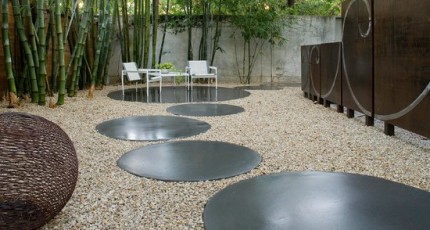Houston Patios & Gardens

Houston patios and gardens go hand in hand. A patio provides a surface for sitting or standing (people often like to do both), and a garden provides an organic framework around the hardscape that encloses its inorganic surface with elements of vitality and life. This sense of living enclosure makes patio space feel warm, inviting, and intimate, regardless of the size of the patio we are talking about.
Most Houston patio and garden design is done in the back yard. Wherever such areas are developed, special space is literally formed out of the landscape that is dedicated to specific activities and states of mind.
On larger properties, such as River Oaks, patios and gardens can also be built in the front yard. Many people here like a seating area near the sidewalk where they can visit with passing neighbors and get a panoramic view of the neighborhood.
There are countless patio sizes and styles that clients can choose from. The appropriateness of a given style, material build, and hardscape size directly correlates to the nature of the activity that will occur on the patio and the aesthetic constraints of the home architecture and landscape design.
There are many elements out of which a hardscape can be constructed. Just a few of these include decorative concrete, ornate stonework, elaborate brick designs, or treated wood. Which one of these works best with a particular style of landscaping—such as Traditional, Contemporary, French, Modern, etc.—is determined through consultation with the client guided by the landscape designer’s professional expertise.
Weather patterns and seasonal temperatures also play a big role in Houston patio and garden design. Different times of the year witness different outdoor activities and pursuits. In order for these events to be comfortable to homeowners and guests, it is necessary for the landscape designer to incorporate some means of climate control into a patio and any corresponding structure that surrounds it.
This climate control can be something as simple as an overhanging tree or a decorative canopy stretched over a seating area. Canopies are very popular for outdoor parties in the spring and add a sense of vertical dimension and festivity to outdoor occasions.
For the hotter summer months we may need to build outdoor buildings with ceiling fans or even simple AC systems to cool things down. Arbors, outdoor living rooms, and summer kitchens are popular structures for entertaining guests in the months of July, August, and September. Gardens around these structures have to be planted with shade resistant species because the plants themselves will naturally receive less sunlight.
In the cooler months of the year, and when weather conditions are extremely cloudy and sometimes very rainy, patio and garden design must be undertaken with a tighter focus. The outdoor environments we build for winter events must be much more self-contained in order to keep people warm, dry, and comfortable.
Garden plants here must be species that flourish in cooler climates, flower in the winter, and able to take heavy rainfall. Drainage is also a major consideration here because December-February in Houston can often see heavy thunderstorms or flash floods that can make outdoor environments uninhabitable and plants wash away if preventative measures are not taken in advance.
Popular structures for this time of the year are patios with outdoor fireplaces and entry gardens with fire pits and lighted fountains. Decorative heaters can also be installed on these patios to make certain that warmth is evenly distributed throughout the open space. Winter canopies can even be stretched over seating areas to prevent sporadic rainfall from dampening the moment.
On clear February nights, however, an evening outdoors on an Exterior Worlds lighted patio and garden space can be just as enjoyable—and perhaps even a bit more romantic and mystical—than a typical summer evening that many take for granted in our traditionally warm climate.
